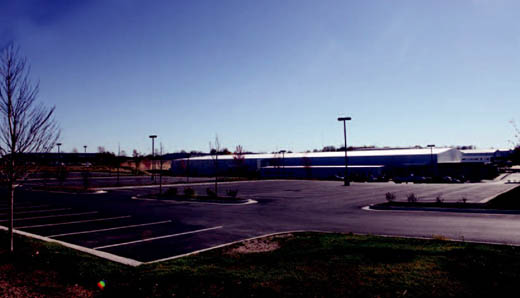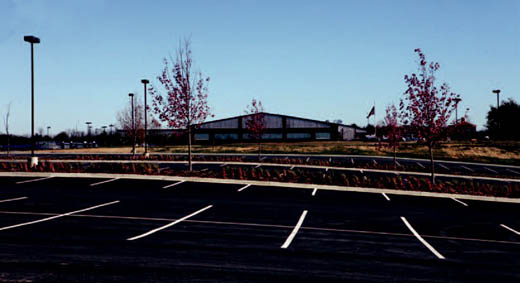IBM site gets unusual stormwater variance
Carfax plans to build two rain gardens and an enormous basin to filter and contain stormwater flowing off the roof of a planned 10,000-square-foot addition.
Carfax, which is expanding to keep up with the demand for its vehicle history reports, will spend more than $55,000 to comply with the city’s stormwater ordinance. The rules require a developed area to absorb as much rainwater after construction as the area did before construction.
At the IBM site directly behind Carfax, construction workers paved a 3.5-acre parking lot to accommodate the hundreds of employees expected to work at the new service center.
Unlike the Carfax site, there will be no rain gardens to filter and clean stormwater that runs off the parking lot. A city variance allowed the project to go forward without addressing one of the two main requirements in the ordinance — water quality.
A CBT review of all stormwater variances granted since June 2008 found that even when the city does grant a variance for a project that increases impervious surface, it still requires developers to use techniques such as pervious pavement and rain gardens to filter stormwater runoff.
Several local engineering consultants said they would not be able to get a variance like the one granted for the IBM site. Although local developers and consultants often struggle to meet expensive stormwater regulations, the IBM site, which will be owned by the city once the company moves in, was not held to the same standard.
The city’s stormwater ordinance has two broad goals. One is detaining water to slow its flow into watersheds. The other is to clean the water that flows from buildings and parking lots. That requires techniques known as best management practices, or BMPs, which are used to clean the water before it enters the watersheds. Pervious pavement and rain gardens are some of those techniques.

“Due to the need for parking, there are no options on site for surface treatment of stormwater quality,” John Holmes, an Allstate engineer, wrote in a June request for a stormwater variance granted by the Department of Public Works.
The stormwater ordinance gives the director of Public Works the authority to grant variances to the ordinance after a review by building and site development staff. Since June 17, 2008, developers and engineers have requested 36 variances for water quality. Only four have been denied, according to a review of city documents.
Builders must use BMPs that give a site credit toward a required “level of service.” Depending on the size of the site, the amount of impervious surface being added and other factors, a development is assigned a level of service it must meet.

Based on the stormwater manual, the IBM site was required to meet a level of service of 5.0. It will only be meeting a water quality level of service of .27. The site is getting a .27 credit for plans to plant about 190 trees off site.
Shane Creech, the supervising engineer of development in Public Works, reviews every variance request before it is sent to the director. He said he and his staff try to remain consistent, but there were many things about the IBM project that were “unique.”
“I can’t think of an example that would be that far from the level-of-service requirement,” Creech said.
Holmes, the Allstate engineer, said his firm “did the best we could do on that site.” In his variance request, he made the case that the 800 jobs IBM has said it will create should be weighed against the city’s stormwater requirements.
“I think … something we need to look at more often is how many jobs we’re creating compared to just the little amount of pavement we’re adding,” Holmes said.
Although putting BMPs such as rain gardens in place would have reduced parking space, porous pavement would not have. In his letter, Holmes wrote that porous pavement was not feasible due to the soil quality.
“That one might have been reaching a little bit,” said Rob Christensen, owner of Christensen Asphalt and Christensen Construction Company.
He and local engineers said the region is full of clay soil that doesn’t absorb water well. So to use porous pavement, developers must scoop out a layer of soil and put in a layer of rock, which is covered with the pervious pavement. That way water can filter through. It’s a technique many projects have used around town. But it is about 30 percent more expensive than traditional asphalt, Christensen said.
Creech agreed that much of the area’s soil is poor but that pervious pavement can still be used.
“There’s always a middle ground,” Creech said. “There’s probably something that could have been done.”
Holmes said much of the porous pavement installed around town has not “held up” and deteriorates rapidly.
Because the city will own the site when IBM occupies it, the maintenance of any BMPs would be its responsibility.
Developer Steve Wendling said he was not surprised the variance was granted. When he built Providence South Plaza earlier this year, Wendling said he had to donate right-of-way valued at $750,000 to the city for a stormwater easement. He also had to put in pervious pavement, which costs about $3.50 more per square foot than regular asphalt.
“If the city wants to do it, and it involves them and benefits them, they’ll circumvent anything to get things done,” Wendling said. “That’s the way it’s been for years.”
Local engineers said the IBM variance highlights the need for the city to come up with ways for developers to pay for stormwater management when they can’t fit the necessary controls onto their site.
“I’d like to see the city give us the option to pay a reasonable amount to do something off site where we can have a bigger impact,” Holmes said.


